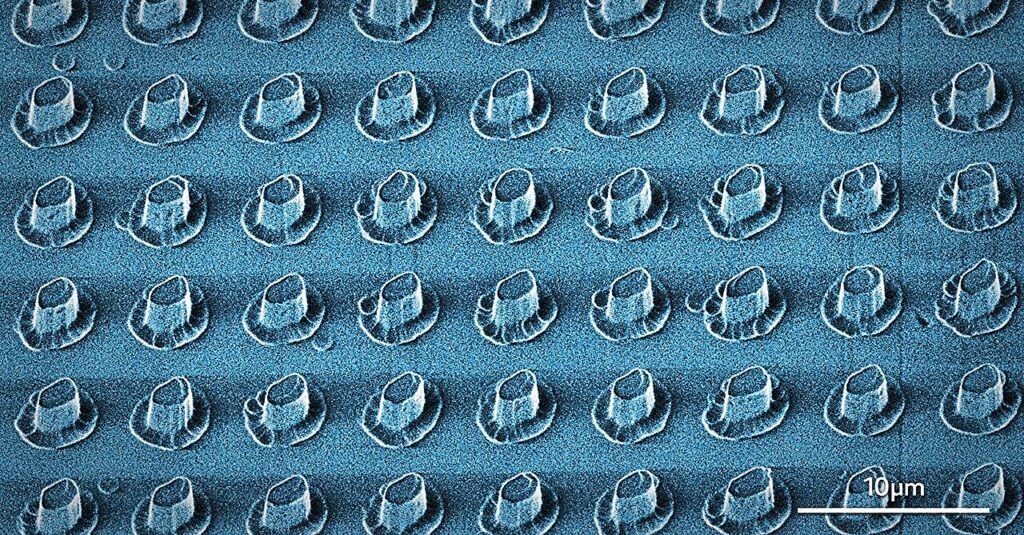The surfaces that cells come into contact with can influence how the cells grow, function, and communicate—shaping metabolism and even cellular health. Now, engineering researchers at the University of California San Diego have developed a platform for studying the ways that nanoscale growing surfaces can impact cellular behavior.
The team, led by bioengineers and nano engineers at the UC San Diego Jacobs School of Engineering, describe this platform in action in a recent paper published in the journal Chemical & Biomedical Imaging.
“The surfaces we developed are much more representative of actual tissue structures. This is very different from conventional laboratory studies that often rely on flat, featureless surfaces for cell growth. These nanoscale structures in our experiments can better replicate the architectures and forces cells experience in the body,” explained UC San Diego nano and chemical engineering Ph.D. student Einollah (Ali) Sarikhani, the co-first author on the new paper.
Sarikhani is a member of Professor Zeinab Jahed’s lab in the Aiiso Yufeng Li Family Department of Chemical and Nano Engineering at the UC San Diego Jacobs School of Engineering. Sarikhani is also a Siebel Scholar at UC San Diego.
While previous studies have shown how surface structures can change cellular shape, little is known about their specific effects on cell metabolism. The UC San Diego engineering research team was able to study these effects through an innovative collaboration between two different labs with very different—yet complementary—expertise.
First, the team grew cells on engineered nanopillar substrates and then they observed changes in cell metabolism using a cutting-edge imaging approach that allows for high-resolution, non-invasive study of the metabolism occurring within individual cells.
This imaging platform for non-invasive study of cell metabolism integrates stimulated Raman scattering (SRS), second harmonic generation, and two photon fluorescence (TPF) microscopy.

“SRS imaging technology gives us an unprecedented view into how the metabolic activity of cells responds to engineered nanopillar surfaces,” explained UC San Diego bioengineering Ph.D. student Zhi Li, co-first author of the new paper from the laboratory of Professor Lingyan Shi in the Shu Chien-Gene Lay Department of Bioengineering at the Jacobs School of Engineering.
The research team found that cells grown on engineered nanopillar surfaces show dramatically different metabolic profiles, exhibiting reduced oxidative stress. Oxidative stress can damage cellular components and contribute to aging and disease.
In addition, the researchers found that growing cells on different engineered nanopillar surfaces could change how cells produce and modify lipids, the primary components of cell membranes. Lipids also play crucial roles in cell signaling. These metabolic changes in lipids could have far-reaching implications for conditions like cancer, where abnormal metabolism is a hallmark feature, or inflammatory diseases where oxidative stress plays a key role.
Discover the latest in science, tech, and space with over 100,000 subscribers who rely on Phys.org for daily insights.
Sign up for our free newsletter and get updates on breakthroughs,
innovations, and research that matter—daily or weekly.
“We can observe multiple aspects of cellular metabolism simultaneously at the subcellular level, from cellular oxidative stress to the creation of new proteins and lipids,” said Shi. “The ability to study cellular metabolism by growing cells on these kinds of nanoscale structures opens up exciting new possibilities for designing tissues, studying aging and diseases, and coming up with new therapies.”
The study also revealed that the specific geometry of nanoscale engineered surfaces plays a critical role in determining how cells respond. Using pixel-wise multivariate analysis, for instance, the researchers found that closely spaced features had a stronger impact on cellular metabolism compared to larger, more widely spaced features. “We could use this information to create surfaces that encourage the growth of specific cell types for tissue engineering,” explained Jahed.
The technologies, techniques and findings described in the paper provide researchers with a new playbook and new insights for studying how the microenvironment around cells can shape their metabolic function.
This work has wide-ranging applications, the researchers say. The insights gained from the study could improve drug delivery systems, guide the formation of new tissues, and provide a better understanding of diseases that involve metabolic dysfunction, such as cancer and diabetes.
Regarding the imaging techniques described in this paper, the researchers were able to reveal the metabolic states within living cells through TPF autofluorescence imaging of metabolic coenzymes, nicotinamide adenine dinucleotide (NADH), and flavin adenine dinucleotide (FAD). In addition, the research team employed a combination of SRS imaging and heavy water probing to track and quantitatively measure the syntheses of lipids and protein within cells.


